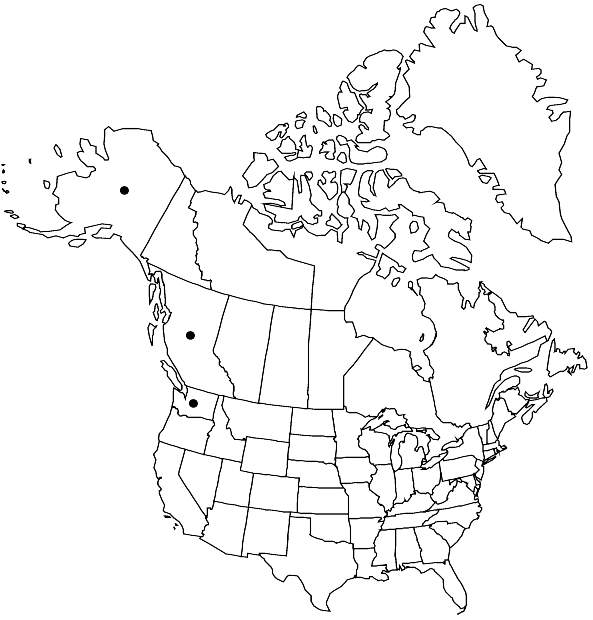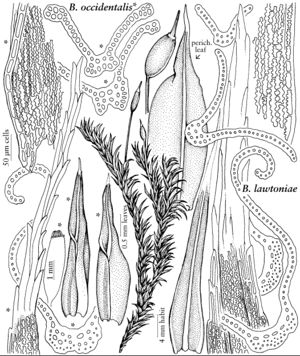Difference between revisions of "Bucklandiella lawtoniae"
in R. Ochyra et al., Cens. Cat. Polish Mosses, 145. 2003 (as lawtonae),.
FNA>Volume Importer |
FNA>Volume Importer |
(No difference)
| |
Revision as of 19:39, 24 September 2019
Plants rather robust or less often moderately sized, loosely tufted, coarse and rigid, slightly glistening, yellow, yellow-green, olivaceous, sometimes grayish, in the upper part, brown proximally. Stems 5–10(–15) cm, curved-ascending to erect, simple or sparingly, irregularly branched. Leaves erect-appressed to falcate-secund when dry, erect-spreading when wet, straight or curved, sometimes almost circinate, (3.5–)4–5.5(–6) × (0.5–)0.6–0.8(–0.9) mm; margins broadly recurved on one side and more narrowly on the other side to 1/3–1/2(–3/4) of the leaf length, 1-stratose throughout or seldom with some bistratose patches distally; pilose, awns hyaline, not flexuose, erect-recurved to squarrose, 0.4–1.5(–2.6) mm, rarely almost absent, flattened, with a distinct cell areolation, remotely sharply denticulate at the margins, distinctly decurrent; costa percurrent, strongly convex abaxially, reniform in the median and proximal portions, 75–100(–115) µm wide basally, 40–50 µm wide distally, 3(–5)-stratose basally with (3–)4–5 enlarged adaxial cells, 2(–3)-stratose distally, with 2–3(–4) enlarged adaxial cells; laminal cells 1-stratose throughout, smooth; basal laminal cells elongate, 25–55 × 9–11 µm, with incrassate, sinuose-nodulose lateral walls; alar cells not or slightly differentiated, sometimes slightly yellowish; supra-alar cells hardly differentiated, not forming a distinct basal marginal border; medial and distal cells rectangular, 12–35 × 5–7 µm. Inner perichaetial leaves (2–3) broadly ovate, convolute, yellowish haline, shortly obtusely pointed or pilose, with thick-walled, chlorophyllose distal cells. Seta 4.5–7.5 mm, straight, brown, twisted clockwise. Capsule obloid to short-cylindric, (1.2–)1.5–2.5 × 0.6–0.8 mm; operculum rostrate, straight, 1–1.5 mm; peristome teeth 250–480 µm, brown, deeply cleft into to branches, strongly papillose, erect. Spores 12–17 µm, granulose.
Habitat: Humid or wet, mostly shaded acidic rocks, boulders, cliffs and rock outcrops near streams and waterfalls
Elevation: low to moderate elevations (0-800 m)
Distribution

B.C., Alaska, Wash.
Discussion
Bucklandiella lawtoniae occurs along the coastal region from Kodiak Island and southern Alaska southwards to the Cascade Range in central Washington, with a highly isolated site on Attu Island in the Aleutians. The largest species of the genus, it can be recognized by its characteristic, long and not flexuose, erect-recurved to squarrose, hyaline awns that are distinctly decurrent. Some elongate and pilose plants of B. affinis may imitate B. lawtoniae but that species, apart from a number of differences in structural characters including the hyaline innermost perichaetial leaves, has erect-flexuose awns and leaf margins recurved on both sides towards the apex. The same differences exist between B. lawtoniae and B. heterosticha, in which, additionally, the costa is usually broad, 2-stratose, and canaliculate in the middle and distal parts of the leaf. Additional diagnostic characters of B. lawtoniae are undifferentiated alar cells and the absence of both a basal marginal border and a basal membrane in the peristome. The species appears to be strongly isolated in the genus and on account of its peculiar innermost perichaetial leaves it is positioned in a separate section.
